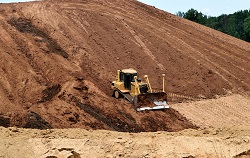
Moulding Sand, Types, Composition and its Properties
In this article, you will learn about the properties of moulding sand.
Moulding Sand and its Properties
In foundries, sand is used to make moulds. Natural sand is found in the bed and banks of rivers. It is an abundant source, although high-quality silica sand is also mined. Sand is chemically SiO2 Silicon dioxide in granular form. Ordinary river sand has a percentage content of clay, moisture, Non-metallic impurities and traces of magnesium and calcium salts, as well as silica grains. This sand, after proper treatment, is used for mould making. A good, well-prepared moulding sand should have following properties:
Properties of Moulding Sand
(i) Refractoriness, i.e. it must be able to withstand high temperatures.
(ii) Permeability, that is, the ability to allow gases, water vapor, and air to pass through it.
(iii) Strength of green sand, i.e. when a mould is made from wet sand, it should have sufficient force, otherwise the mould will break.
(iv) Good flowability, i.e. when packed around a pattern in a mould box, it should be able to fill in all the nooks and corners, otherwise, the imprint of the pattern on the mould will not be sharp and clear.
(v) Good collapsibility, i.e. it should fall off easily after the casting cools. This is especially important in the case of core making.
(vi) Cohesiveness, that is, the ability of sand grains to stick together. Moulds, without harmonization
You will lack strength.
(vii) Viscosity, i.e. the ability of sand to stick to other bodies. If the moulding sand doesn’t stick on the walls of the mould box, the whole mould will slide through the box.
Properties such as permeability, cohesiveness, and green power depend on the size and shape of the grains of sand, as well as the binder material and the amount of moisture present in the sand. Clay is a natural binder. Chemical binders such as bentonite are sometimes added if natural sand does not have enough clay content.
Moulding Sand Composition
The fresh moulding sand prepared in the foundry should have the following composition:
- Silica 75% (approx.)
- Soil 10-15%
- Bentonite 2-5% (as required)
- Coal dust 5-10%
- Humidity 6–8%
Core sand contains oil as the main binding material. A core surrounded by molten metal causes the oil to evaporate. This increases the collapsibility of the sand and makes it easier to remove the holes in the casting.
Sand Testing
Moulding sand and core sand depend on the size, shape composition and distribution of the sand grain, clay content, moisture, and additives. Increased demand for good surface finish and high precision in casting requires certainty in the quality of the mould and the sand of the core.
Sand testing often allows the use of less expensive local sand. It also ensures reliable sand allows mixing and utilization of the inherent properties of moulding sand. Sand test in process delivery will immediately detect any variation from the standard quality and will adjust sand blend to specific requirements to minimize casting defects. Therefore, the sand test is a key factors in the foundry and is amortized achieving a lower cost per unit and increased production as a result of sound casting. The following tests are usually performed
to judge the moulding and pouring characteristics of foundry sand:
- Moisture content test
- Testing of soil materials
- Chemical composition of the sand
- The size and surface texture of the sand grains.
- Distribution of the size of the grains of sand
- Specific surface area of sand grains
- Water absorption capacity of sand
- refractoriness of the sand
- Strength test
- Permeability test
- Fluency test
- Fragmentation index test
- Mould hardness test
Frequently Asked Questions
How many kinds of Moulding sand are there?
There are many kinds of moulding sand which are:
1. Green Sand
2. Dry Sand
3. Loam Sand
4. Facing Sand
5. Baking Sand
6. System Sand
7. Parting sand
8. Core Sand
Also Read Properties of Fluid
